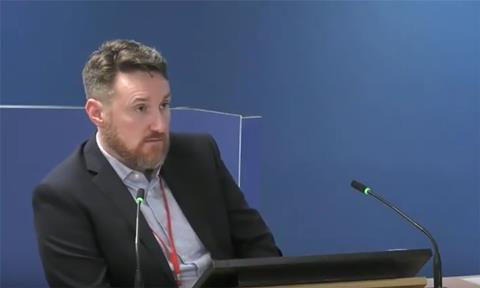A round-up of the evidence given at the Grenfell Inquiry by the project’s main contractor
Grenfell Tower refurbishment main contractor Rydon was centre stage this week, explaining its role on the ill-fated upgrade that turned the ageing 1970s block into a death trap.
The inquiry’s main witness was Simon Lawrence, Rydon’s contracts manager on the project from spring 2014 until he left the firm late the following year.
A recurring theme in Lawrence’s evidence was that Rydon had not needed in-house expertise on fire safety and cladding because it had specialist subcontractors and designers to rely on – including original architect Studio E and facade specialist Harley.

But by the end of his four days of evidence, Lawrence conceded that, looking back, the one thing he would do differently on the project would be to buy-in more design expertise.
He said: “In hindsight, I think it would be good to employ – whether directly or indirectly – some more technical … as in design… ability to check the design. Over and above the designers that we already had.”
It was the only example Lawrence gave.
Throughout his evidence, the contracts manager accepted that he did not have a detailed understanding of key safety guidance and product information that have a direct relevance to fire that engulfed the newly-refurbished Grenfell Tower in June 2017, with the loss of 72 lives.
“I wouldn’t give technical assurances unless I had that information from the designers or specialists.”
Simon Lawrence, Rydon contracts manager on Grenfell Tower refurbishment
On his first day of evidence he admitted he did not know cavity barriers were needed around windows or that insulation on buildings above 18m had to be of “limited combustibility” – a term he said he had not fully understood at the time.
Lawrence was also asked about several guidance documents that relate to high-rise cladding projects, including the Building Control Alliance’s “Use of Combustible Cladding Materials on Residential Buildings”. He said he had not seen them.
On Monday, the inquiry heard that Rydon had won its role on the Grenfell refurbishment project with a bid that was £212,000 lower than it should have been because of an “adding-up error”.
This week’s Grenfell Inquiry coverage
Grenfell Inquiry: Rydon manager admits team needed more design expertise
Grenfell contractor ‘didn’t know’ cladding options had different fire safety ratings
Main contractor accused of ‘pocketing’ savings to cover Grenfell pricing mistake
Grenfell main contractor ‘did not check architect’s expertise’
At the same time, client Kensington & Chelsea Tenant Management Organisation (KCTMO) needed to make £800,000 of savings – meaning Rydon needed to shave more than £1m from its £9.2m winning bid for the work.
Value engineering options included substituting the refurbishment project’s first choice of a zinc cassette system for face-fixed aluminium cladding. Rydon told KCTMO the move would save £376,175 but four days earlier subcontractor Harley Facades had quoted a saving of £576,973.
Lawrence told the inquiry he assumed the savings were not being passed on in full so they could offset risk or deliver “additional profit”.
Tuesday’s session heard that Rydon would have preferred to fit face-fixed ACM to Grenfell as part of the refurbishment project because it was the cheapest option. But the firm feared the visible rivets would be less aesthetically acceptable than ACM cassettes.
“In hindsight, I think it would be good to employ – whether directly or indirectly – some more technical … as in design… ability to check the design. Over and above the designers that we already had.”
Simon Lawrence, Rydon contrracts manager on Grenfell Tower refurbishment
Cassette-form Reynobond PE was ultimately attached to Grenfell Tower. Lawrence told the inquiry that he had not been aware that it had a worse fire-safety rating than the face-fixed version of Reynobond PE – and doubted whether anyone else at Rydon knew.
Also on Tuesday, Lawrence denied ever telling KCTMO head of capital investment David Gibson that the cladding proposed for Grenfell Tower would be “inert”, as Gibson maintains in his evidence to the inquiry.
Lawrence said Gibson’s recollections were wrong. He added: “I wouldn’t give technical assurances unless I had that information from the designers or specialists.”
On Wednesday, Lawrence was quizzed about a range of observations he made about contractors. He had described one carpentry firm as delivering a standard of work that was “too good for what we need in refurb”. Elsewhere, he had blamed the project slipping behind schedule on “poor surveying and cheap, incompetent subcontractors”.
Rydon’s original project manager for Grenfell Tower gave evidence on Thursday. Simon O’Connor told the inquiry that although he had worked for the firm since 2002, Grenfell had been his first job as a project manager and the first time he had worked directly with cladding.
O’Connor, giving evidence from behind a screen, said he resigned from Rydon in July 2015 because of “pressures at the project”.
“We were falling behind programme; there was a lot of pressure and I was given the opportunity to join another company for significantly more money and another opportunity,” he explained.



























No comments yet